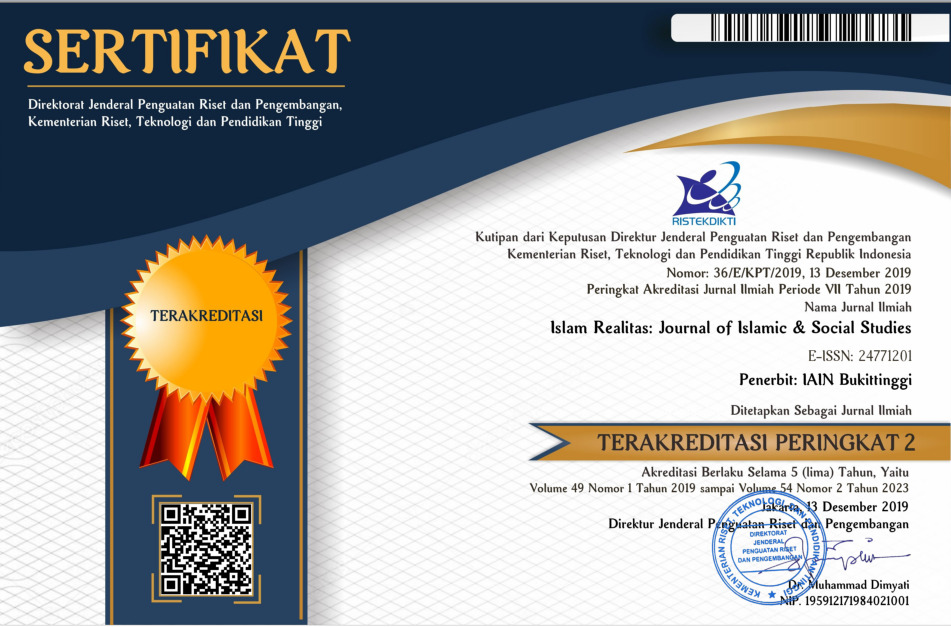The Contribution of KH. Said Agil Siradj's Leadership in Fighting Radicalism: A Language Communication Strategy
Downloads
Additional Files
This article aimed to describe Said Agil Siradj's communication strategy at the anniversary of Fatayat NU in 2019. Radicalism and terrorism have become a real threat to world peace and human values. In Indonesia, it has been categorised as an extraordinary crime, particularly since the Bali bombings in 2002. The act of anticipation has been issued by forming anti-terrorism regulation to prevent and crackdown of its action. Nevertheless, this effort is not sufficient to eradicate terrorism action. Collaboration with religious institutions is needed to deal with the questions of the religious doctrines. Therefore, the participation of religious leaders from the Islamic organisations such as Nahdlatul Ulama (NU) is essential.. The study employs a descriptive qualitative approach of critical discourse analysis, focusing on the illocutionary acts of speech acts theory. The data of the research was transcribed from the video of SAS’s speech on YouTube channel. The result shows that the speaker used types of illocutionary acts; representatives, directives, commisives, expressives, and declarations. These expressions are used to command, persuade, and warn the listeners. Meanwhile, the Islamic terms were used as a discursive practice to maintain a good relationship between a leader and the followers.
Tulisan ini menjelaskan tentang bagaiamana Said Agil Siradj (SAS) mempengaruhi pendengarnya pada acara ulang tahun Fatayat NU ke-73 tahun 2019. Radikalisme dan terorisme telah menjadi ancaman bagi perdamaian dan nilai-nilai kemanusian. Di Indonesia, tindak terorisme telah menjadi bentuk kejahatan yang luar biasa sejak kejadian bom Bali 2002. Bentuk antisipasi telah dilakukan yakni dengan menerbitkan undang-undang anti-terorisme untuk menangkal dan mengatasi aksi terorisme. Penegakan hukum dan kebijakan regulasi telah dikeluarkan dalam rangka menangkalnya. Namun demikian, tindakan ini belum cukup memadai dalam pemberantasan terorisme. Kolaborasi dengan Lembaga-lembaga keagamaan diperlukan guna menjawab terkait doktrin-doktirn keagamaan. Oleh karena itu partisipasi para pemimpin agama dan organisasi keislaman seperti NU adalah penting. Namun demikian pelibatan organisasi keagamaan dalam kontek ini telah memicu munculnya perdebatan terutama Ketika organisasi tersebut mendominasi peran dalam ranah public. Studi ini didesain berdasarkan deskripsi kualitatif pada pendekatan analisis wacana kritis yang berfokus pada tindak illokusi berdasarkan teori tindak tutur. Data penelitian ini diambil dari transkripsi Video SAS yang diambil dari YouTube. Selanjutnya data dianalisis menggunakan teori tindal ilokusi dan analsis wacana. Hasil penelitian menunjukkan bahwa pembicara menggunakan tipe-tipe tindak tutur pada bentuk representasi, direktif, komisif, ekspresi dan deklarasi. Ekpresi-ekpresi tersebut digunakan untuk memerintah, membujuk dan melarang para pendengarnya.Adapun istilah-istilah keislaman digunakan sebagai praktik diskursif guna membangun hubungan social antara pemimpin dan pengikutnya.
Books
Aspinal, Edward, and Berenschort, Ward, Democracy for Sale: Elections, Clientelism, and the State in Indonesia (New York: Cornel University Press, 2019).
Asy’ari, Muhammad Hasyim, Risalah Ahlussunah wal Jama’ah : Analisis Tentang Hadits Kematian, Tanda-tanda Kiamat, dan Pemahaman Tentang Sunah dan Bid’ah, (Jakarta: LTM PBNU dan Pesantren Ciganjur, 2011),(translation) p.12-22
Austin, J.L. How to do Things with Words, (Great Britain: Oxford University Press, 1962).
Baso, A., Sunyoto, A., dan Mummaziq, R., KH. Hasyim Asy’ari: Pengabdian Seorang Kyai untuk Negeri (Jakarta: Museum Kebangkitan Nasional RI, 2017).
Blommaert, Jan. Discourse: A Critical Introduction (New York: Cambridge University Press, 2005)
Bush, Robin, Nadhlatul Ulama & the Struggle for Power within Islam & Politics in Indonesia, (Singapore: ISEAS Publishing, 2009).
Fairclough, Norman, Critical Discourse Analysis: the Critical Study of Language (New York: Longman, 279).
Jainuri, Achmad, ‘The Formation of Muhammadiyah Ideology, 1912 -1942’, Disertasi (McGill University: the Institute of Islamic Studies, 1997).
Searle, John R., A Taxonomy of Illocutionary Acts (Minneapolis: University of Minnesota Press, 1975). Retrieved from the University of Minnesota Digital Conservancy, http://hdl.handle.net/11299/185220. p.344-369
--------, Expression and Meaning: Studies in Theory of Speech Acts (New York: Cambridge University Press, 1979).
Wodak, Ruth & Meyer, M., Methods of Critical Discourse Analysis, (Great Britain: SAGE Publications, 2001).
Journals
Altikriti, Sahar, “Persuasive Speech Acts in Barrack Obama’s Inaugural Speeches (2009, 2013) and The Last State of the Union Address (2016)â€. International Journal of Linguistics, 8.2 (2016). 10.5296/ijl.v8i2.9274.
Conger, Jay A. “Inspiring Others: the language of leadershipâ€, Academy of Management Executive, 5 (1991). 31. 10.2307/4164992.
Fairclough, Norman L. ‘Critical and Descriptive Goals in Discourse Analysis’, Journal of Pragmatics 9.6 (1985): 739-63.
Fealy, G., & White, H., ‘Indonesia’s ‘Great Power’ Aspirations: A Critical View’, Asia & the Paciï¬c Policy Studies, 3. 1 (2016), 9. doi:10.1002/app5.122.
Gusthini, M., Sobarna, C., & Amalia, R.M., ‘A Pragmatic Study of Speech as an Instrument of Power: Analysis of the 2016 USA Presidential Debate’, Studies in English Language and Education, 5:1 (2018), doi.org/10.24815/siele.v5i1.6906
Hana, Atiya Mahmud, ‘Speech Acts in Barack Obama Speech’s in Announcing the Death of Osama Bin Laden’, WEJ, 2.2 (2018), 10.31943/wej.Vol2.Iss2.336.
Ismail, Faisal, ‘The Nahdlatul Ulama: Its Early History And Contribution To The Establishment Of Indonesian State’, Journal of Indonesian Islam, 5, (2011), 241, 10.15642/JIIS.2011.5.2.247-282
Kusumawati, Anggara Jatu ‘A Discourse Analysis of SBY’s International Speech Text: A Study on Critical Linguistics’, Journal of English and Education, 5.1, (2011).https://journal.uii.ac.id/JEE/article/view/4454/3939.
Mengibar, Ana Caballero. ‘Critical Discourse Analysis in The Study of Representation, Identity Politics and Power Relations: A Multi-method Approach’, Communication & Society, 38 (2015). 2. 10.15581/003.28.2.39-54.
Mietzner, Marcus, ‘Fighting Illiberalism with Illiberalism: Islamist Populism and Democratic Deconsolidation in Indonesia’, Pacific Affairs, 91.2 (2018). https://dx.doi.org/10.5509/2018912261
Shukry, Azimah Shurfa Mohammed, ‘A critical discourse analysis of Mahathir Mohamad’s speeches on the “war on terror’, Intellectual Discourse, 21.2 (2013)
Wijsen, Frans, ‘Discourse Analysis in Religious Studies: The Case of Interreligious Worship in Friesland’, Anthropos, 105 (2010), 1-15
Yuniawan, Tommi, Rustono, Funadah, Luluk A., Wicaksono, Harits A., and Maretta, Y.A., ‘Deixis Analysis in The Speech of President Joko Widodo at the Inaguration’, International Journal of Scientific & Technology Research, 9.3 (2020), www.ijstr.org.
Copyright (c) 2020 Bambang Hariyanto

This work is licensed under a Creative Commons Attribution-ShareAlike 4.0 International License.
Authors who publish with this journal agree to the following terms:
- Authors retain copyright and grant the journal right of first publication with the work simultaneously licensed under a Creative Commons Attribution License that allows others to share the work with an acknowledgment of the work's authorship and initial publication in this journal.
- Authors are able to enter into separate, additional contractual arrangements for the non-exclusive distribution of the journal's published version of the work (e.g., post it to an institutional repository or publish it in a book), with an acknowledgment of its initial publication in this journal.
- Authors are permitted and encouraged to post their work online (e.g., in institutional repositories or on their website) prior to and during the submission process, as it can lead to productive exchanges, as well as earlier and greater citation of published work (See The Effect of Open Access).









